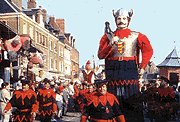Name origin. The name Bustraan is probably a corruption of “bûcheron,” the French word for “woodsman” or “logger.” A reference to a book by F. Debrabandere (“Verklarend woordenboek van de familienamen in Belgie en Noord-Frankrijk”) at the Meertens Instituut website indicates that Bustraan morphed from Buts(e)raen and Butseroen. It further suggests that these Dutch names were derived from the French “bûcheron.” Through my research, I have found various spellings of the name.
 John the Woodcutter. Having just mentioned Steenvoorde above, this French town just a few kilometers from the Belgian border is the home of the mythical giant Jean le Bûcheron (or, Jan den Houtkapper). Giants, large figures carried in annual religious processions, are a colorful Flemish tradition dating back to the early 16th century, although Jean himself is of a more recent vintage. In neighboring Western Flanders there is a forested area called the Het Houtland (The Woodland). Not an unlikely place for a family of loggers originate, don’t you think? Steenvoorde. Poperinge. Ieper. All are close by one another. It’s all connected…
John the Woodcutter. Having just mentioned Steenvoorde above, this French town just a few kilometers from the Belgian border is the home of the mythical giant Jean le Bûcheron (or, Jan den Houtkapper). Giants, large figures carried in annual religious processions, are a colorful Flemish tradition dating back to the early 16th century, although Jean himself is of a more recent vintage. In neighboring Western Flanders there is a forested area called the Het Houtland (The Woodland). Not an unlikely place for a family of loggers originate, don’t you think? Steenvoorde. Poperinge. Ieper. All are close by one another. It’s all connected…
Spelling variations. So far I’ve found 20 spellings of the name in source documents. In these variations you can literally see Dutchmen struggling to phonetically spell the French word “bûcheron.” I have only recently realized that Bustraan is the second most common spelling. Butstraen (found mostly in Flanders) is the most frequent. Butseraen (still found in Flanders). Bustraen (found today in NL, BE, and FR). The rest are no longer used (I think). Busstraan. Butseraan. Butseran. Bestraan. Bestraans. Busstraen. Busraen. Busseraen. Busseraens. Busseraan. Busseraans. Buseraan. Butzeran. Butzeraan. Butzeram. Bastraan. This is all kind of hypnotic to look at. Are there others?